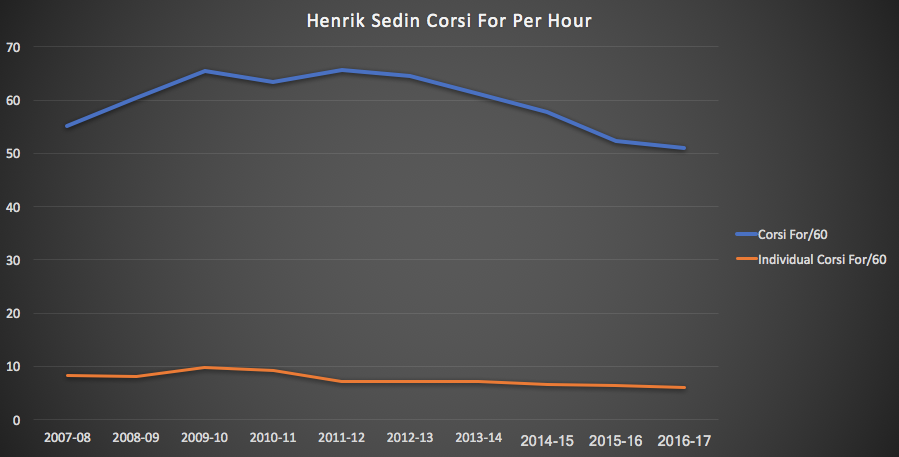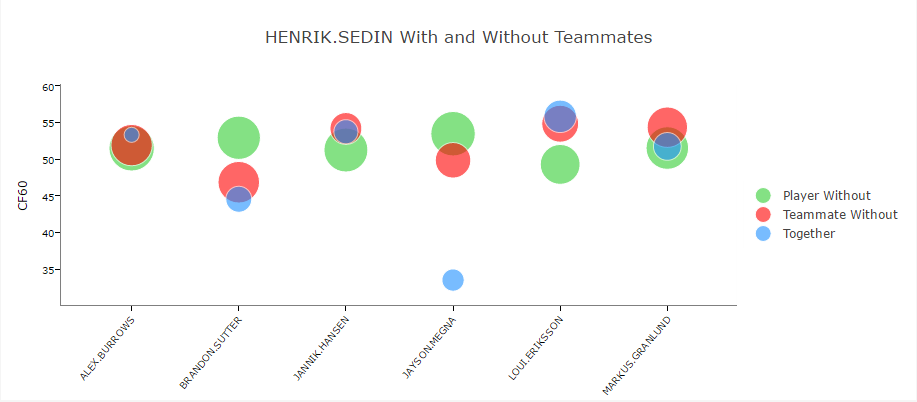Blame Perfect Storm Of Age-Related Decline, Poor Linemates For Sedins’ Disappointing Season

7 years ago
The Sedin twins are not what they once were. Just two seasons ago we were talking about “renaissance” years for Henrik and Daniel, in which both players eclipsed 70 points.
That feels like a lifetime ago now.
Barring an unforeseen hot streak down the stretch, it’s likely both Sedins won’t even get to 50 points. They’re on pace for their worst seasons in nearly a decade. How did this happen?
The most obvious culprit is aging, something Jason Botchford alluded to in a recent piece for The Province:
No one viewed the Sedins as top-20 scorers. But no one thought they’d drown either.Maybe they weren’t entirely submerged in water, but they spent many nights gasping for air, and because of it they will end this season feeling they cost the Canucks some games for the first time in their careers.“I feel like we should have produced more than we have this year, that’s for sure,” Henrik revealed. “A lot of games it felt really good, we just weren’t able to put the puck in the net. The power play is a huge part of that. It hasn’t been working.“It’s a year where we have felt we have cost us games and that hasn’t happened before. That’s something we have to get back next year. We have to be better.”It sounded like the first public concession that age is catching up to the Sedins.
The numbers definitely back up the assertion that the Sedins’ decline is age-related. We know based on work done by Eric Tulsky that players generally reach their offensive peak around age 25, and their production really begins to drop precipitously after 30. Tulsky used points per sixty to illustrate this point, but given the volatility of shooting percentage and the multiple changes the Sedins have seen in teammate quality, this can sometimes be misleading. Shot rates, on the other hand, should be a bit less influenced by luck, so I decided to take a look at how many shots per hour the Sedins have been on the ice for since that data began being tracked in 2007. If we used Henrik as a proxy for his line, we can see that the Sedins’ ability to drive shot attempts has decreased to it’s lowest rate on record, down 10% from where they were in 2014-15.

So yes, it’s clear that Father Time is catching up with the Sedin twins.
I wouldn’t put the blame entirely on their shoulders, however. Environmental factors have also conspired to limit the Sedins’ effectiveness. The first factor is quite obvious. If you’re an avid reader of this site you may already be ahead of me.
The Sedins have played with their lowest quality of teammates since 2008-2009. Obviously, quality of teammate metrics aren’t perfect, and run into even more problems when two players spend as much time together as the Sedins do, but the closer you look, the more this becomes apparent. While the Sedins have made a career out of propping up lesser players, it’s been years since they’ve played such a significant portion of their even-strength minutes with such anchors. Henrik Sedin (and, by extension, Daniel Sedin) has spent almost one quarter of his even-strength ice-time with one of Brandon Sutter or Jayson Megna. We’ve devoted entire articles to how inept those two have been with the Twins, but just to recap:
- The Sedins and Brandon Sutter had just a 47% share of shot attempts, a 29% share of scoring chances, and carried an expected goals-for percentage of 35% while on the ice together.
- The Sedins and Jayson Megna had just a 37% share of shot attempts, a 40% share of scoring chances, and carried an expected goals-for percentage of 37.6% while on the ice together.
- In 156:33 minutes of TOI with Brandon Sutter, Sutter managed three goals but no assists. Daniel had just 2 assists, Henrik 3, and 1 goal.
- In 83:08 minutes of TOI with Jayson Megna, The Sedins managed just one goal between the two of them, and no assists. Megna had 0s across the board.
Even if you aren’t a fan of advanced player evaluation metrics, it’s pretty obvious that neither of these players provided the Sedins with any real offensive value. Megna’s scored just 4 goals all season, and while Brandon Sutter possesses a good shot, he provides absolutely no playmaking value, evidenced by his total of five primary assists on the season.
But that only accounts for 23% of the Sedins’ even-strength time-on-ice. Their most common linemate this season has been Loui Eriksson, who hasn’t been a drag on the Sedins’ ability to drive shots and possession at all. In fact, the Sedins and Eriksson have controlled just north of 55% of the shot attempts when on the ice at even-strength.
The probably lies with what an absurdly terrible season Eriksson has had. Not only are his shot rates down, but he’s also had awful shooting luck, seeing his shooting percentage plunge to 8.3%, down significantly from his career average of 13.5%.
Still, when we dig past the traditional boxcar stats, Eriksson’s actually had a good year, despite his truly atrocious luck. He’s also had a positive impact on the Sedins’ ability to drive play:

With Loui Eriksson, the Sedins have produced shots at just a hair under the rate that they were managing in 2014-15, when both players surpassed the 70-point threshold. I wouldn’t expect them to be reaching those heights again, but Eriksson is exactly the type of player that should be able to have a positive impact on the Sedins’ offensive output. That just hasn’t been the case yet.
The Canucks’ abysmal power play doesn’t help matters either. Again, the Sedins’ advanced age has an effect, but so too do a number of coaching issues. The Sedins have based their entire careers off of cycling and making 5-foot passes, and yet on the power play, they’re almost completely static, and on opposite sides of the rink. Loui Eriksson, player who’s at his goal-scoring best when he’s cleaning up garbage in front of the net, has had limited opportunity to do so, with Desjardins consistently opting to place Brandon Sutter in his stead.
Astonishingly, all the data we have available suggests the Sedins play better with better players. Crazy, I know. That’s the type of hard-hitting analysis I get paid literally tens of dollars to produce. The problem is, unlike in prior seasons, they just aren’t capable of elevating weaker players anymore. At this stage in their careers, they truly need an equal to play with. Unfortunately, the only one they’ve had to play with this season is mired in shooting percentage-hell.
If the coaching staff can limit their minutes a bit more, and keep them away from anchors like Brandon Sutter and Jayson Megna, I can’t see a reason why top-six production from the Sedins won’t be attainable again.
That’s why I take issue with their assertion that they’ve let the team down. Quite the opposite, in fact. I think if anything, the team has let them down. Its coaching staff has let them down by consistently deploying role-players on their right wing, and using them ineffectively with the man advantage, and its management has let them down by failing to insulate them with enough talent to keep their minutes down where they ought to be at this stage in their respective careers.
When you consider that the team’s management has so often used the Sedins as a reason they can’t undergo a traditional rebuild, that’s a tough pill to swallow.





